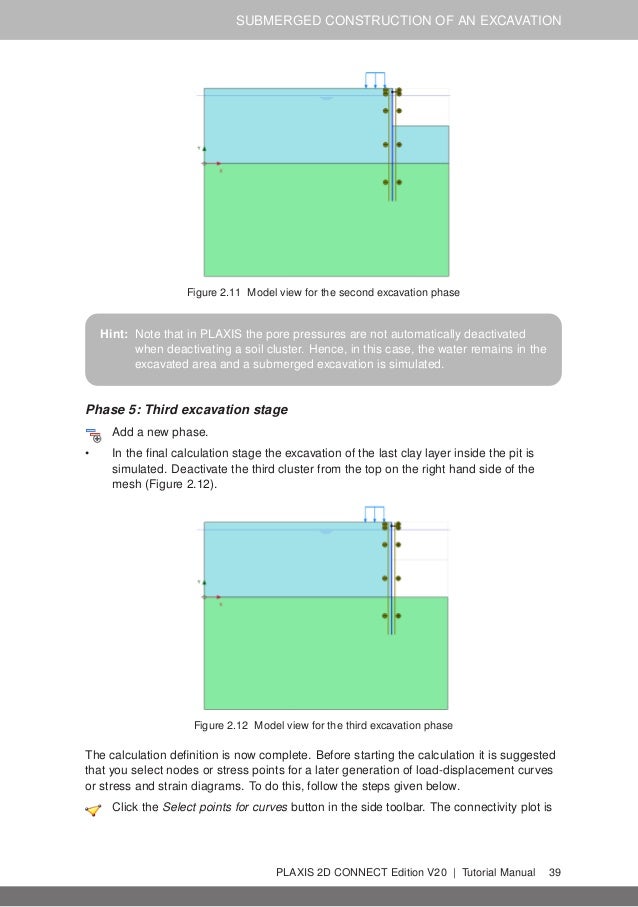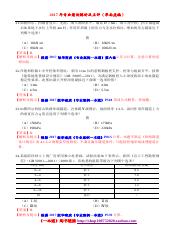

- #PLAXIS 2D TUTORIAL MANUAL MANUAL#
- #PLAXIS 2D TUTORIAL MANUAL FULL#
- #PLAXIS 2D TUTORIAL MANUAL WINDOWS#
If the 2D mesh is satisfactory, an extension into the third dimension can be made by specifying the z-coordinates of all vertical planes that are needed to create the three-dimensional model. After the creation of a geometry model, a 2D finite element mesh composed of 6-node triangles can automatically be generated, based on the composition of clusters and lines Actions related to clusters apply to all elements in the cluster. Hence, clusters can be regarded as parts of soil layers. Within a cluster the soil properties are homogeneous. PLAXIS automatically recognises clusters based on the input of geometry lines. A line can have several functions or properties.Ĭlusters: Clusters are areas that are fully enclosed by lines. Lines: Lines are used to define the physical boundaries of the geometry, the model boundaries and discontinuities in the geometry such as walls or shells, separations of distinct soil layers or construction stages. Points can also be used for the positioning of anchors, point forces, point fixities and for local refinements of the finite element mesh. Points: Points form the start and end of lines.

The three types of components in a cross-section model are described below in more detail. The model must be sufficiently large so that the boundaries do not influence the results of the problem to be studied. A cross-section model should include a representative division of the subsoil into distinct soil layers, structural objects, construction stages and loadings. A cross-section model is a 2D representation of a real three-dimensional problem and consists of points, lines and clusters. 2.2įor each new 3D project to be analysed it is important to create a 2D cross-section model first. 2.1įor the installation procedure the user is referred to the General Information section in this manual. Whenever keys on the keyboard or text buttons on the screen need to be pressed, this is indicated by the name of the key or button in brackets, (for example the key).
#PLAXIS 2D TUTORIAL MANUAL WINDOWS#
In the manuals, menu items or windows specific items are printed in Italics.

This chapter describes some of the notation and basic input procedures that are used in the PLAXIS 3D Tunnel program.
#PLAXIS 2D TUTORIAL MANUAL FULL#
In addition to the full set of manuals, short courses are organised on a regular basis at several places in the world to provide hands-on experience and background information on the use of the program. For detailed information on the available program features, the user is referred to the Reference Manual. The latter can be found in the Material Models Manual, as included in the full manual, and theoretical background is given in the Scientific Manual.
#PLAXIS 2D TUTORIAL MANUAL MANUAL#
The Tutorial Manual does not provide theoretical background information on the finite element method, nor does it explain the details of the various soil models available in the program. The tutorial lessons are also available in the examples folder of the program directory PLAXIS 3D Tunnel and can be used to check your results. It is further recommended that the lessons are followed in the order that they appear in the manual. It is helpful, but not essential, that users have experience with the standard PLAXIS (2D) deformation analysis program. Users are expected to have a basic understanding of soil mechanics and should be able to work in a Windows environment. The various lessons deal with a range of interesting practical applications and cover most of the program features. This Tutorial Manual is intended to help new users become familiar with the PLAXIS 3D Tunnel program. This concept enables new users to work with the package after only a few hours of training. The calculation itself is fully automated and based on robust numerical procedures. The simple graphical input procedures enable a quick generation of complex finite element models, and the enhanced output facilities provide a detailed presentation of computational results. The PLAXIS 3D Tunnel program is a finite element package that has been developed specifically for the analysis of deformation and stability in tunnel projects. 6-11Īppendix A - Menu structure Appendix B - Calculation scheme for initial stresses due to soil weight Stability of a Diaphragm wall excavation (lesson 4). Staged construction of NATM tunnel (lesson 2).4-1 4.1 Geometry. 3-2 3.2.1 Creating the input.3-2 3.2.2 Performing calculations.

Settlement of square footing on sand (lesson 1).3-1 3.1 Geometry. 2-4 2.3.4 Structured input.2-6 2.4 Starting the program. 2-1 2.3 Input procedures.2-3 2.3.1 Input of Geometry objects.2-3 2.3.2 Input of text and values.


 0 kommentar(er)
0 kommentar(er)
